MN5009 Leadership and Leading: Power, Politics and Conflicts
VerifiedAdded on 2022/08/12
|10
|2591
|26
Report
AI Summary
This report delves into the critical aspects of power, politics, and conflict within the organizational environment, using the case of Samsung as a practical example. It begins by defining power as a crucial factor influencing business activities, highlighting its multi-directional nature and impact on leadership effectiveness. The report then explores organizational politics, differentiating between legitimate and illegitimate behaviors and their impact on power dynamics. It emphasizes the importance of ethical leadership in managing politics and preventing negative consequences. Furthermore, the report examines workplace conflicts, identifying their causes, such as unclear responsibilities, resource scarcity, and interpersonal relationships. It analyzes how these conflicts can hinder organizational efficiency and spread negativity. Finally, the report concludes by summarizing the interconnectedness of power, politics, and conflict, emphasizing the need for strategic practices in leadership to ensure both employee well-being and organizational success, as demonstrated by Samsung's approach to these challenges.
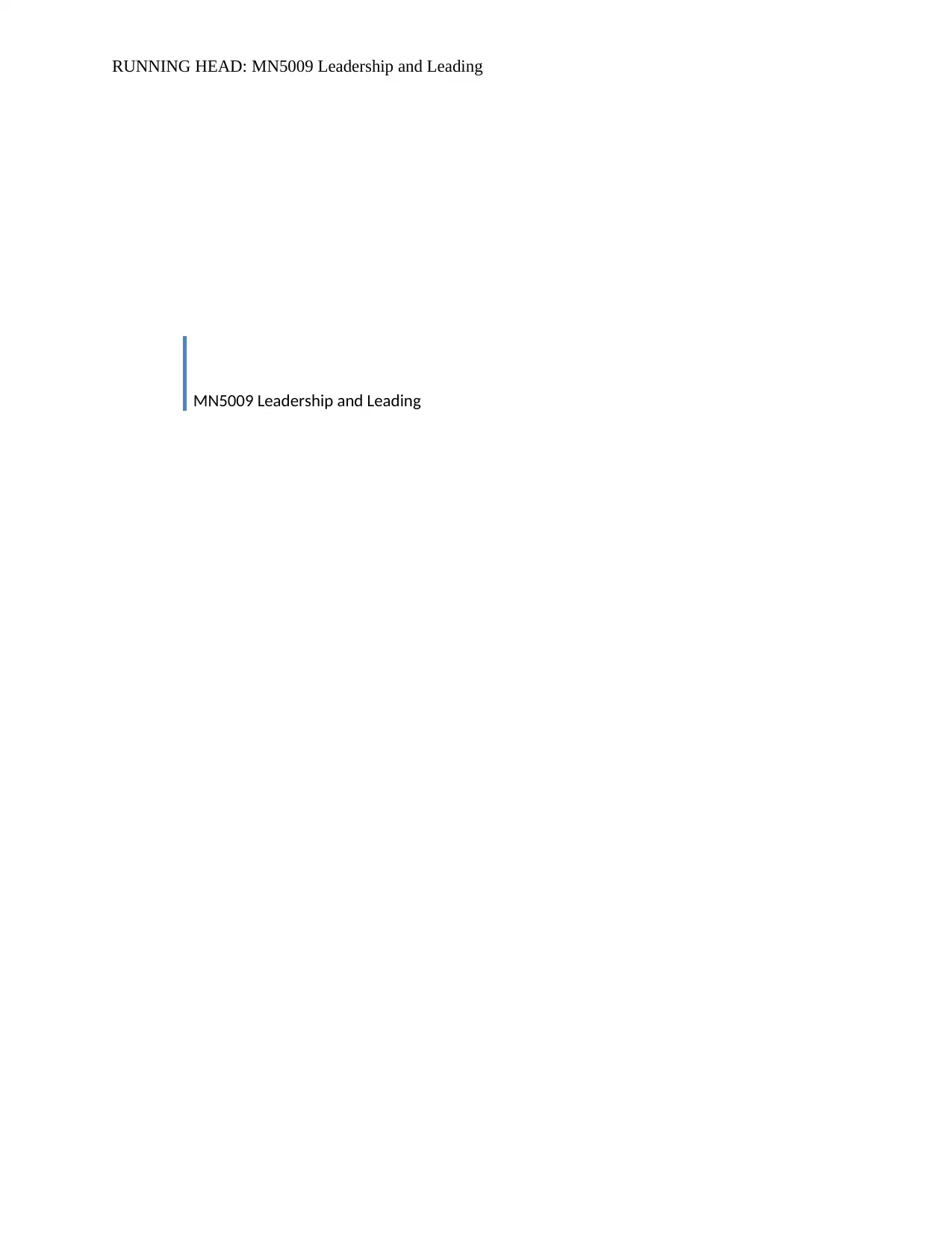
RUNNING HEAD: MN5009 Leadership and Leading
MN5009 Leadership and Leading
MN5009 Leadership and Leading
Paraphrase This Document
Need a fresh take? Get an instant paraphrase of this document with our AI Paraphraser
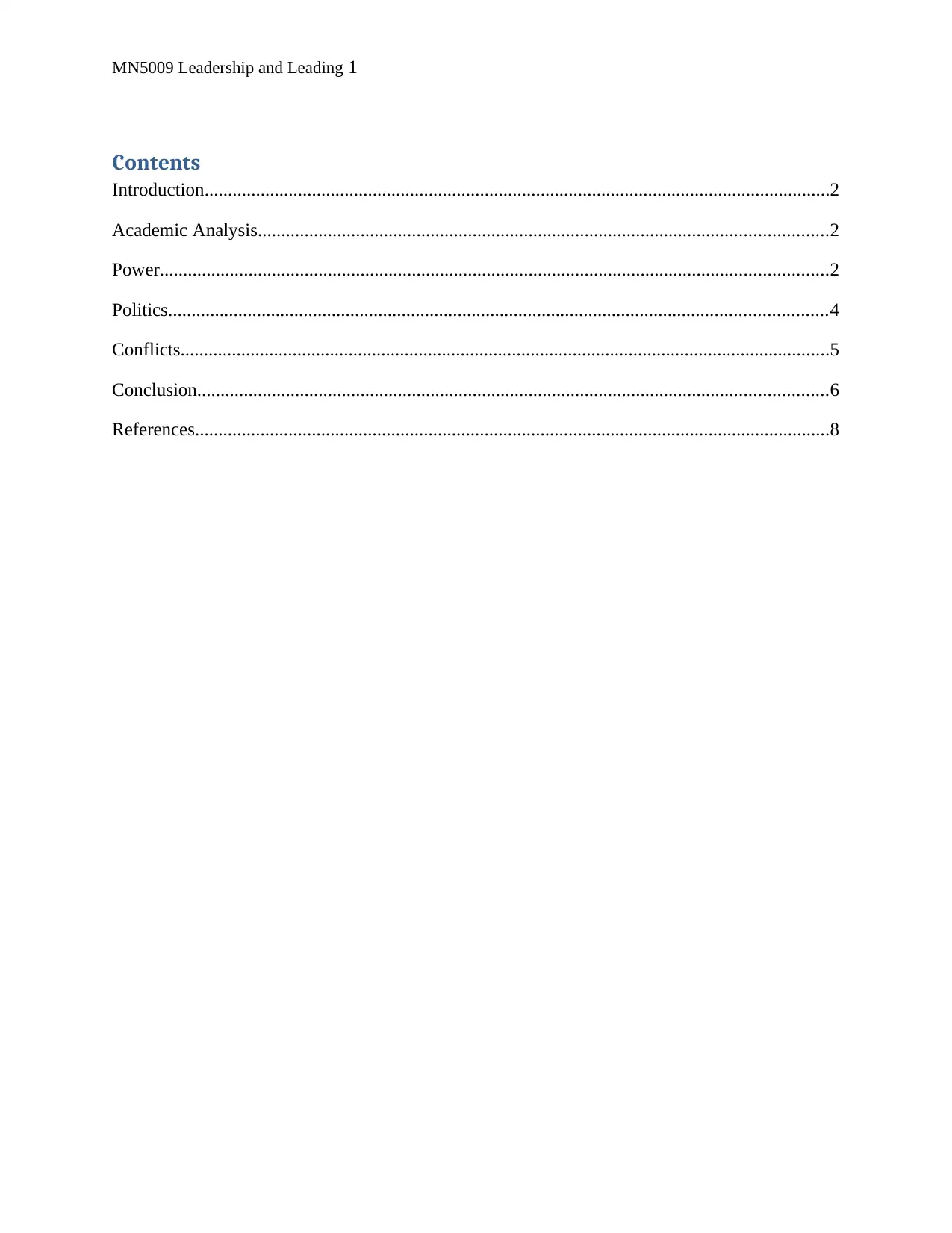
MN5009 Leadership and Leading 1
Contents
Introduction......................................................................................................................................2
Academic Analysis..........................................................................................................................2
Power...............................................................................................................................................2
Politics.............................................................................................................................................4
Conflicts...........................................................................................................................................5
Conclusion.......................................................................................................................................6
References........................................................................................................................................8
Contents
Introduction......................................................................................................................................2
Academic Analysis..........................................................................................................................2
Power...............................................................................................................................................2
Politics.............................................................................................................................................4
Conflicts...........................................................................................................................................5
Conclusion.......................................................................................................................................6
References........................................................................................................................................8
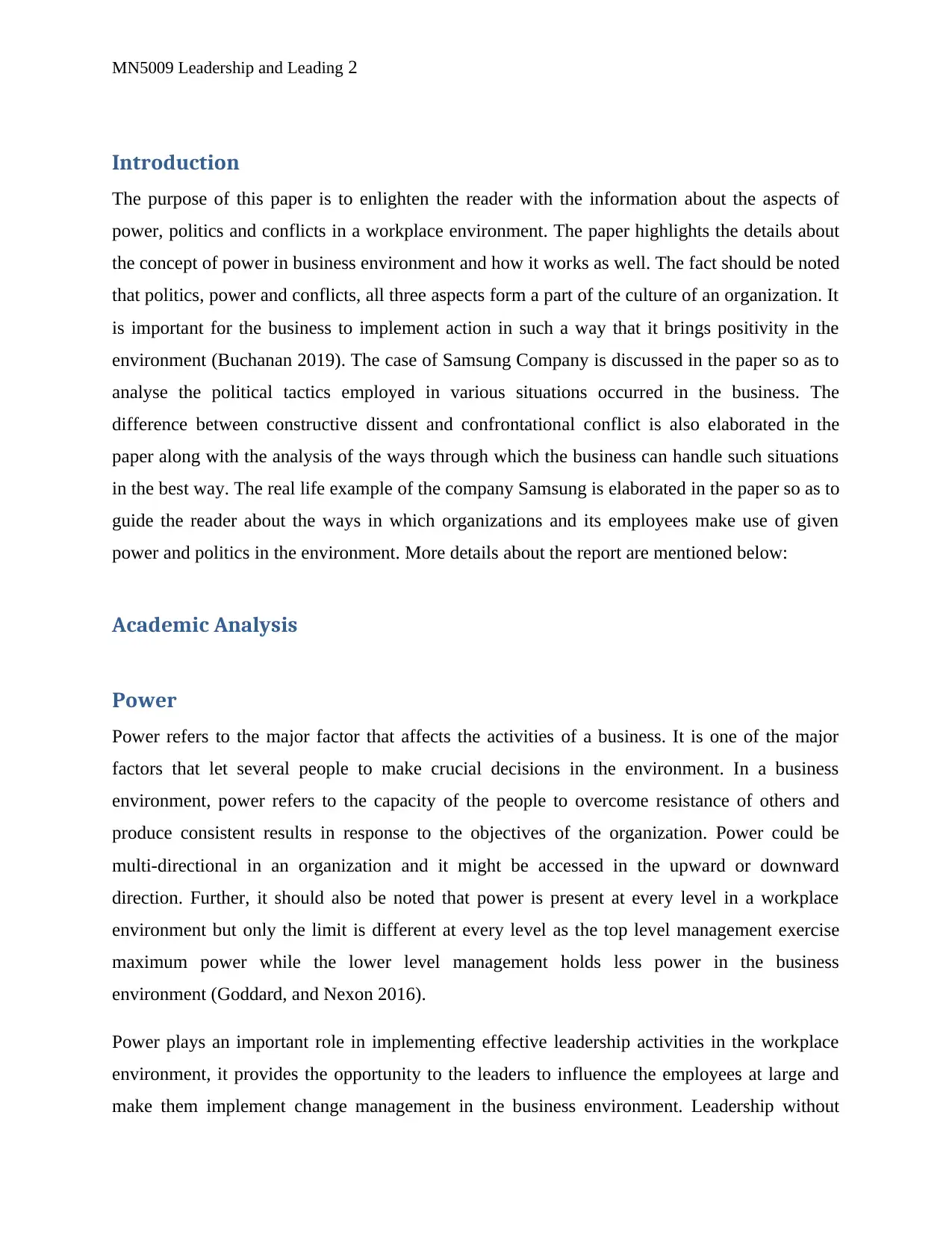
MN5009 Leadership and Leading 2
Introduction
The purpose of this paper is to enlighten the reader with the information about the aspects of
power, politics and conflicts in a workplace environment. The paper highlights the details about
the concept of power in business environment and how it works as well. The fact should be noted
that politics, power and conflicts, all three aspects form a part of the culture of an organization. It
is important for the business to implement action in such a way that it brings positivity in the
environment (Buchanan 2019). The case of Samsung Company is discussed in the paper so as to
analyse the political tactics employed in various situations occurred in the business. The
difference between constructive dissent and confrontational conflict is also elaborated in the
paper along with the analysis of the ways through which the business can handle such situations
in the best way. The real life example of the company Samsung is elaborated in the paper so as to
guide the reader about the ways in which organizations and its employees make use of given
power and politics in the environment. More details about the report are mentioned below:
Academic Analysis
Power
Power refers to the major factor that affects the activities of a business. It is one of the major
factors that let several people to make crucial decisions in the environment. In a business
environment, power refers to the capacity of the people to overcome resistance of others and
produce consistent results in response to the objectives of the organization. Power could be
multi-directional in an organization and it might be accessed in the upward or downward
direction. Further, it should also be noted that power is present at every level in a workplace
environment but only the limit is different at every level as the top level management exercise
maximum power while the lower level management holds less power in the business
environment (Goddard, and Nexon 2016).
Power plays an important role in implementing effective leadership activities in the workplace
environment, it provides the opportunity to the leaders to influence the employees at large and
make them implement change management in the business environment. Leadership without
Introduction
The purpose of this paper is to enlighten the reader with the information about the aspects of
power, politics and conflicts in a workplace environment. The paper highlights the details about
the concept of power in business environment and how it works as well. The fact should be noted
that politics, power and conflicts, all three aspects form a part of the culture of an organization. It
is important for the business to implement action in such a way that it brings positivity in the
environment (Buchanan 2019). The case of Samsung Company is discussed in the paper so as to
analyse the political tactics employed in various situations occurred in the business. The
difference between constructive dissent and confrontational conflict is also elaborated in the
paper along with the analysis of the ways through which the business can handle such situations
in the best way. The real life example of the company Samsung is elaborated in the paper so as to
guide the reader about the ways in which organizations and its employees make use of given
power and politics in the environment. More details about the report are mentioned below:
Academic Analysis
Power
Power refers to the major factor that affects the activities of a business. It is one of the major
factors that let several people to make crucial decisions in the environment. In a business
environment, power refers to the capacity of the people to overcome resistance of others and
produce consistent results in response to the objectives of the organization. Power could be
multi-directional in an organization and it might be accessed in the upward or downward
direction. Further, it should also be noted that power is present at every level in a workplace
environment but only the limit is different at every level as the top level management exercise
maximum power while the lower level management holds less power in the business
environment (Goddard, and Nexon 2016).
Power plays an important role in implementing effective leadership activities in the workplace
environment, it provides the opportunity to the leaders to influence the employees at large and
make them implement change management in the business environment. Leadership without
⊘ This is a preview!⊘
Do you want full access?
Subscribe today to unlock all pages.

Trusted by 1+ million students worldwide
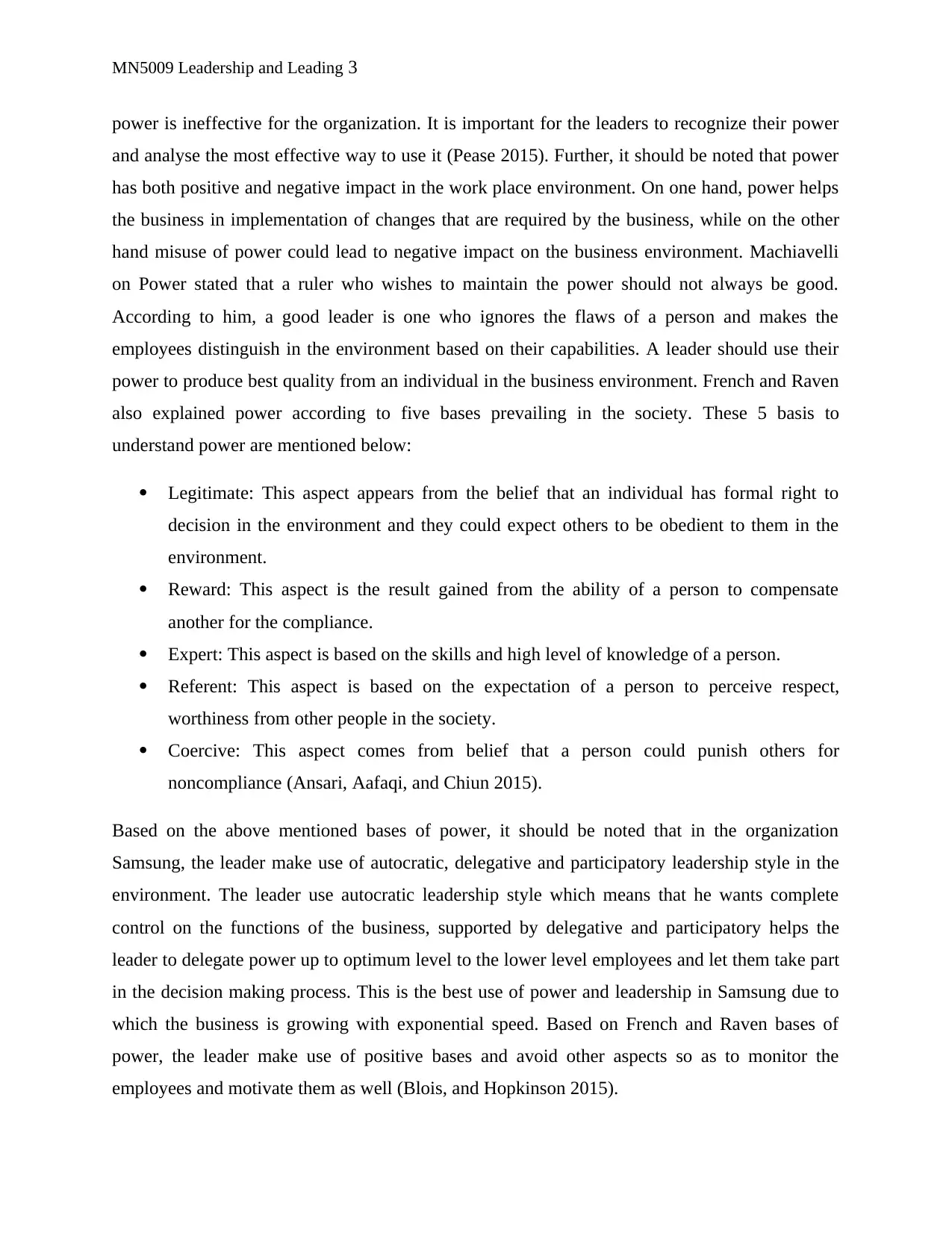
MN5009 Leadership and Leading 3
power is ineffective for the organization. It is important for the leaders to recognize their power
and analyse the most effective way to use it (Pease 2015). Further, it should be noted that power
has both positive and negative impact in the work place environment. On one hand, power helps
the business in implementation of changes that are required by the business, while on the other
hand misuse of power could lead to negative impact on the business environment. Machiavelli
on Power stated that a ruler who wishes to maintain the power should not always be good.
According to him, a good leader is one who ignores the flaws of a person and makes the
employees distinguish in the environment based on their capabilities. A leader should use their
power to produce best quality from an individual in the business environment. French and Raven
also explained power according to five bases prevailing in the society. These 5 basis to
understand power are mentioned below:
Legitimate: This aspect appears from the belief that an individual has formal right to
decision in the environment and they could expect others to be obedient to them in the
environment.
Reward: This aspect is the result gained from the ability of a person to compensate
another for the compliance.
Expert: This aspect is based on the skills and high level of knowledge of a person.
Referent: This aspect is based on the expectation of a person to perceive respect,
worthiness from other people in the society.
Coercive: This aspect comes from belief that a person could punish others for
noncompliance (Ansari, Aafaqi, and Chiun 2015).
Based on the above mentioned bases of power, it should be noted that in the organization
Samsung, the leader make use of autocratic, delegative and participatory leadership style in the
environment. The leader use autocratic leadership style which means that he wants complete
control on the functions of the business, supported by delegative and participatory helps the
leader to delegate power up to optimum level to the lower level employees and let them take part
in the decision making process. This is the best use of power and leadership in Samsung due to
which the business is growing with exponential speed. Based on French and Raven bases of
power, the leader make use of positive bases and avoid other aspects so as to monitor the
employees and motivate them as well (Blois, and Hopkinson 2015).
power is ineffective for the organization. It is important for the leaders to recognize their power
and analyse the most effective way to use it (Pease 2015). Further, it should be noted that power
has both positive and negative impact in the work place environment. On one hand, power helps
the business in implementation of changes that are required by the business, while on the other
hand misuse of power could lead to negative impact on the business environment. Machiavelli
on Power stated that a ruler who wishes to maintain the power should not always be good.
According to him, a good leader is one who ignores the flaws of a person and makes the
employees distinguish in the environment based on their capabilities. A leader should use their
power to produce best quality from an individual in the business environment. French and Raven
also explained power according to five bases prevailing in the society. These 5 basis to
understand power are mentioned below:
Legitimate: This aspect appears from the belief that an individual has formal right to
decision in the environment and they could expect others to be obedient to them in the
environment.
Reward: This aspect is the result gained from the ability of a person to compensate
another for the compliance.
Expert: This aspect is based on the skills and high level of knowledge of a person.
Referent: This aspect is based on the expectation of a person to perceive respect,
worthiness from other people in the society.
Coercive: This aspect comes from belief that a person could punish others for
noncompliance (Ansari, Aafaqi, and Chiun 2015).
Based on the above mentioned bases of power, it should be noted that in the organization
Samsung, the leader make use of autocratic, delegative and participatory leadership style in the
environment. The leader use autocratic leadership style which means that he wants complete
control on the functions of the business, supported by delegative and participatory helps the
leader to delegate power up to optimum level to the lower level employees and let them take part
in the decision making process. This is the best use of power and leadership in Samsung due to
which the business is growing with exponential speed. Based on French and Raven bases of
power, the leader make use of positive bases and avoid other aspects so as to monitor the
employees and motivate them as well (Blois, and Hopkinson 2015).
Paraphrase This Document
Need a fresh take? Get an instant paraphrase of this document with our AI Paraphraser
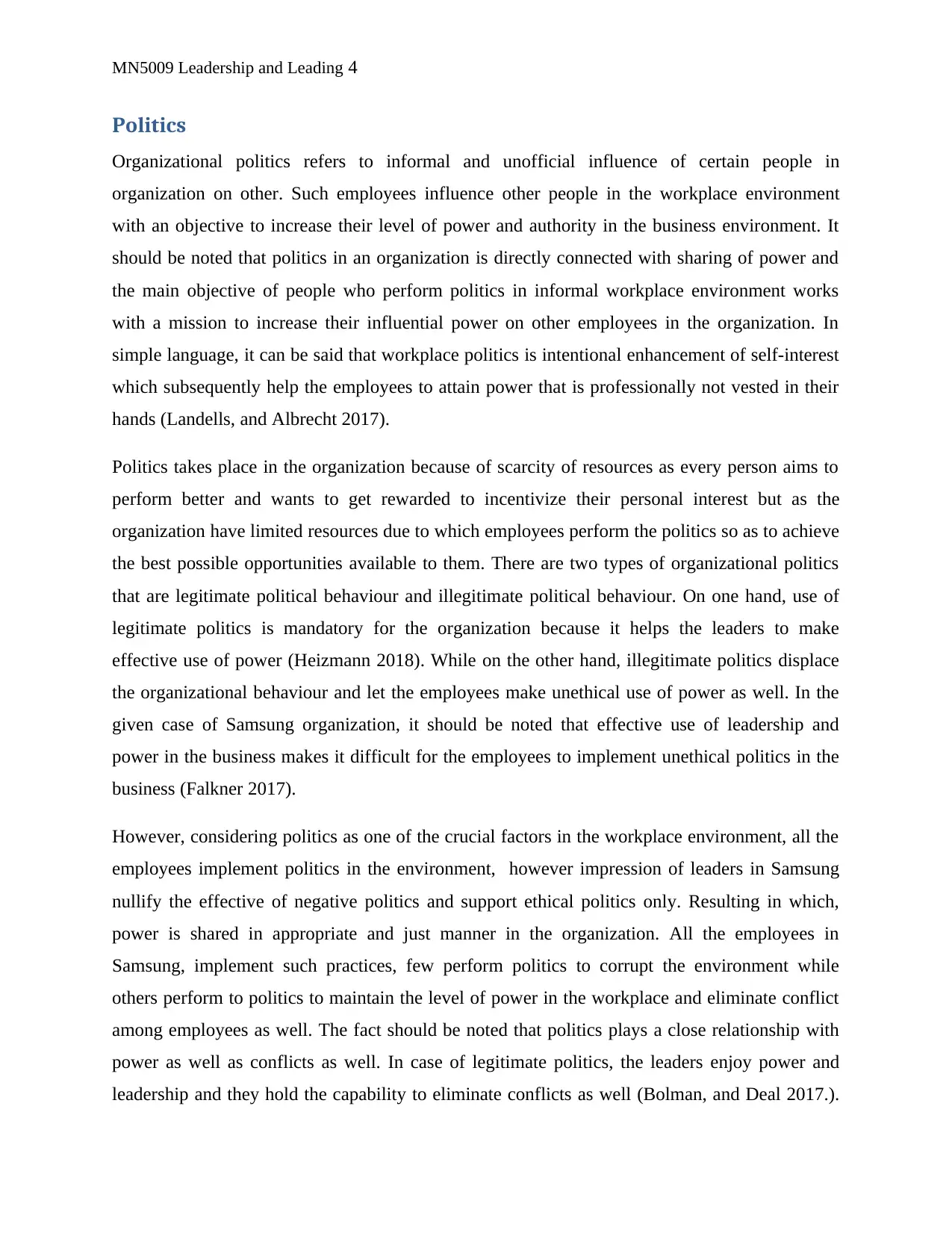
MN5009 Leadership and Leading 4
Politics
Organizational politics refers to informal and unofficial influence of certain people in
organization on other. Such employees influence other people in the workplace environment
with an objective to increase their level of power and authority in the business environment. It
should be noted that politics in an organization is directly connected with sharing of power and
the main objective of people who perform politics in informal workplace environment works
with a mission to increase their influential power on other employees in the organization. In
simple language, it can be said that workplace politics is intentional enhancement of self-interest
which subsequently help the employees to attain power that is professionally not vested in their
hands (Landells, and Albrecht 2017).
Politics takes place in the organization because of scarcity of resources as every person aims to
perform better and wants to get rewarded to incentivize their personal interest but as the
organization have limited resources due to which employees perform the politics so as to achieve
the best possible opportunities available to them. There are two types of organizational politics
that are legitimate political behaviour and illegitimate political behaviour. On one hand, use of
legitimate politics is mandatory for the organization because it helps the leaders to make
effective use of power (Heizmann 2018). While on the other hand, illegitimate politics displace
the organizational behaviour and let the employees make unethical use of power as well. In the
given case of Samsung organization, it should be noted that effective use of leadership and
power in the business makes it difficult for the employees to implement unethical politics in the
business (Falkner 2017).
However, considering politics as one of the crucial factors in the workplace environment, all the
employees implement politics in the environment, however impression of leaders in Samsung
nullify the effective of negative politics and support ethical politics only. Resulting in which,
power is shared in appropriate and just manner in the organization. All the employees in
Samsung, implement such practices, few perform politics to corrupt the environment while
others perform to politics to maintain the level of power in the workplace and eliminate conflict
among employees as well. The fact should be noted that politics plays a close relationship with
power as well as conflicts as well. In case of legitimate politics, the leaders enjoy power and
leadership and they hold the capability to eliminate conflicts as well (Bolman, and Deal 2017.).
Politics
Organizational politics refers to informal and unofficial influence of certain people in
organization on other. Such employees influence other people in the workplace environment
with an objective to increase their level of power and authority in the business environment. It
should be noted that politics in an organization is directly connected with sharing of power and
the main objective of people who perform politics in informal workplace environment works
with a mission to increase their influential power on other employees in the organization. In
simple language, it can be said that workplace politics is intentional enhancement of self-interest
which subsequently help the employees to attain power that is professionally not vested in their
hands (Landells, and Albrecht 2017).
Politics takes place in the organization because of scarcity of resources as every person aims to
perform better and wants to get rewarded to incentivize their personal interest but as the
organization have limited resources due to which employees perform the politics so as to achieve
the best possible opportunities available to them. There are two types of organizational politics
that are legitimate political behaviour and illegitimate political behaviour. On one hand, use of
legitimate politics is mandatory for the organization because it helps the leaders to make
effective use of power (Heizmann 2018). While on the other hand, illegitimate politics displace
the organizational behaviour and let the employees make unethical use of power as well. In the
given case of Samsung organization, it should be noted that effective use of leadership and
power in the business makes it difficult for the employees to implement unethical politics in the
business (Falkner 2017).
However, considering politics as one of the crucial factors in the workplace environment, all the
employees implement politics in the environment, however impression of leaders in Samsung
nullify the effective of negative politics and support ethical politics only. Resulting in which,
power is shared in appropriate and just manner in the organization. All the employees in
Samsung, implement such practices, few perform politics to corrupt the environment while
others perform to politics to maintain the level of power in the workplace and eliminate conflict
among employees as well. The fact should be noted that politics plays a close relationship with
power as well as conflicts as well. In case of legitimate politics, the leaders enjoy power and
leadership and they hold the capability to eliminate conflicts as well (Bolman, and Deal 2017.).
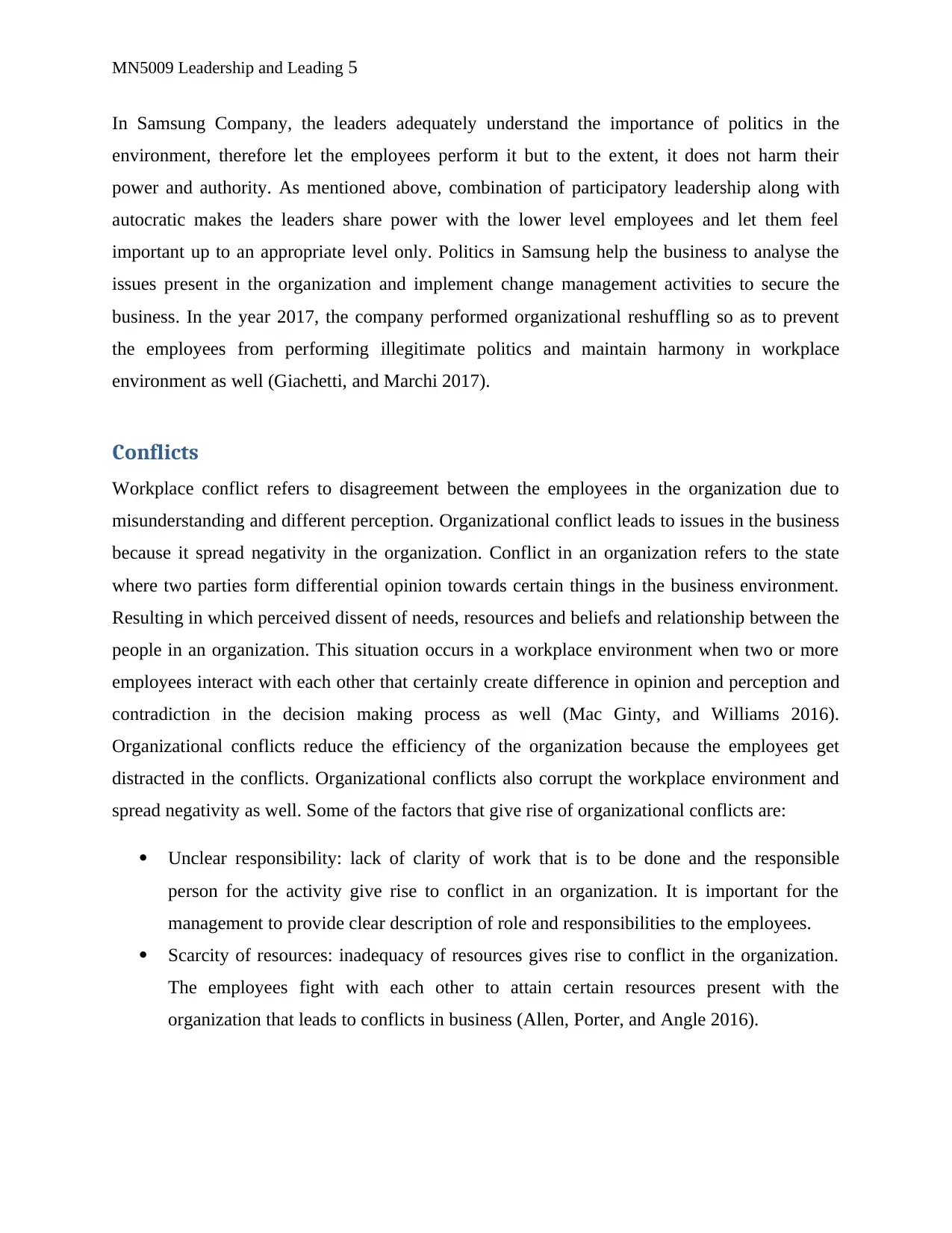
MN5009 Leadership and Leading 5
In Samsung Company, the leaders adequately understand the importance of politics in the
environment, therefore let the employees perform it but to the extent, it does not harm their
power and authority. As mentioned above, combination of participatory leadership along with
autocratic makes the leaders share power with the lower level employees and let them feel
important up to an appropriate level only. Politics in Samsung help the business to analyse the
issues present in the organization and implement change management activities to secure the
business. In the year 2017, the company performed organizational reshuffling so as to prevent
the employees from performing illegitimate politics and maintain harmony in workplace
environment as well (Giachetti, and Marchi 2017).
Conflicts
Workplace conflict refers to disagreement between the employees in the organization due to
misunderstanding and different perception. Organizational conflict leads to issues in the business
because it spread negativity in the organization. Conflict in an organization refers to the state
where two parties form differential opinion towards certain things in the business environment.
Resulting in which perceived dissent of needs, resources and beliefs and relationship between the
people in an organization. This situation occurs in a workplace environment when two or more
employees interact with each other that certainly create difference in opinion and perception and
contradiction in the decision making process as well (Mac Ginty, and Williams 2016).
Organizational conflicts reduce the efficiency of the organization because the employees get
distracted in the conflicts. Organizational conflicts also corrupt the workplace environment and
spread negativity as well. Some of the factors that give rise of organizational conflicts are:
Unclear responsibility: lack of clarity of work that is to be done and the responsible
person for the activity give rise to conflict in an organization. It is important for the
management to provide clear description of role and responsibilities to the employees.
Scarcity of resources: inadequacy of resources gives rise to conflict in the organization.
The employees fight with each other to attain certain resources present with the
organization that leads to conflicts in business (Allen, Porter, and Angle 2016).
In Samsung Company, the leaders adequately understand the importance of politics in the
environment, therefore let the employees perform it but to the extent, it does not harm their
power and authority. As mentioned above, combination of participatory leadership along with
autocratic makes the leaders share power with the lower level employees and let them feel
important up to an appropriate level only. Politics in Samsung help the business to analyse the
issues present in the organization and implement change management activities to secure the
business. In the year 2017, the company performed organizational reshuffling so as to prevent
the employees from performing illegitimate politics and maintain harmony in workplace
environment as well (Giachetti, and Marchi 2017).
Conflicts
Workplace conflict refers to disagreement between the employees in the organization due to
misunderstanding and different perception. Organizational conflict leads to issues in the business
because it spread negativity in the organization. Conflict in an organization refers to the state
where two parties form differential opinion towards certain things in the business environment.
Resulting in which perceived dissent of needs, resources and beliefs and relationship between the
people in an organization. This situation occurs in a workplace environment when two or more
employees interact with each other that certainly create difference in opinion and perception and
contradiction in the decision making process as well (Mac Ginty, and Williams 2016).
Organizational conflicts reduce the efficiency of the organization because the employees get
distracted in the conflicts. Organizational conflicts also corrupt the workplace environment and
spread negativity as well. Some of the factors that give rise of organizational conflicts are:
Unclear responsibility: lack of clarity of work that is to be done and the responsible
person for the activity give rise to conflict in an organization. It is important for the
management to provide clear description of role and responsibilities to the employees.
Scarcity of resources: inadequacy of resources gives rise to conflict in the organization.
The employees fight with each other to attain certain resources present with the
organization that leads to conflicts in business (Allen, Porter, and Angle 2016).
⊘ This is a preview!⊘
Do you want full access?
Subscribe today to unlock all pages.

Trusted by 1+ million students worldwide
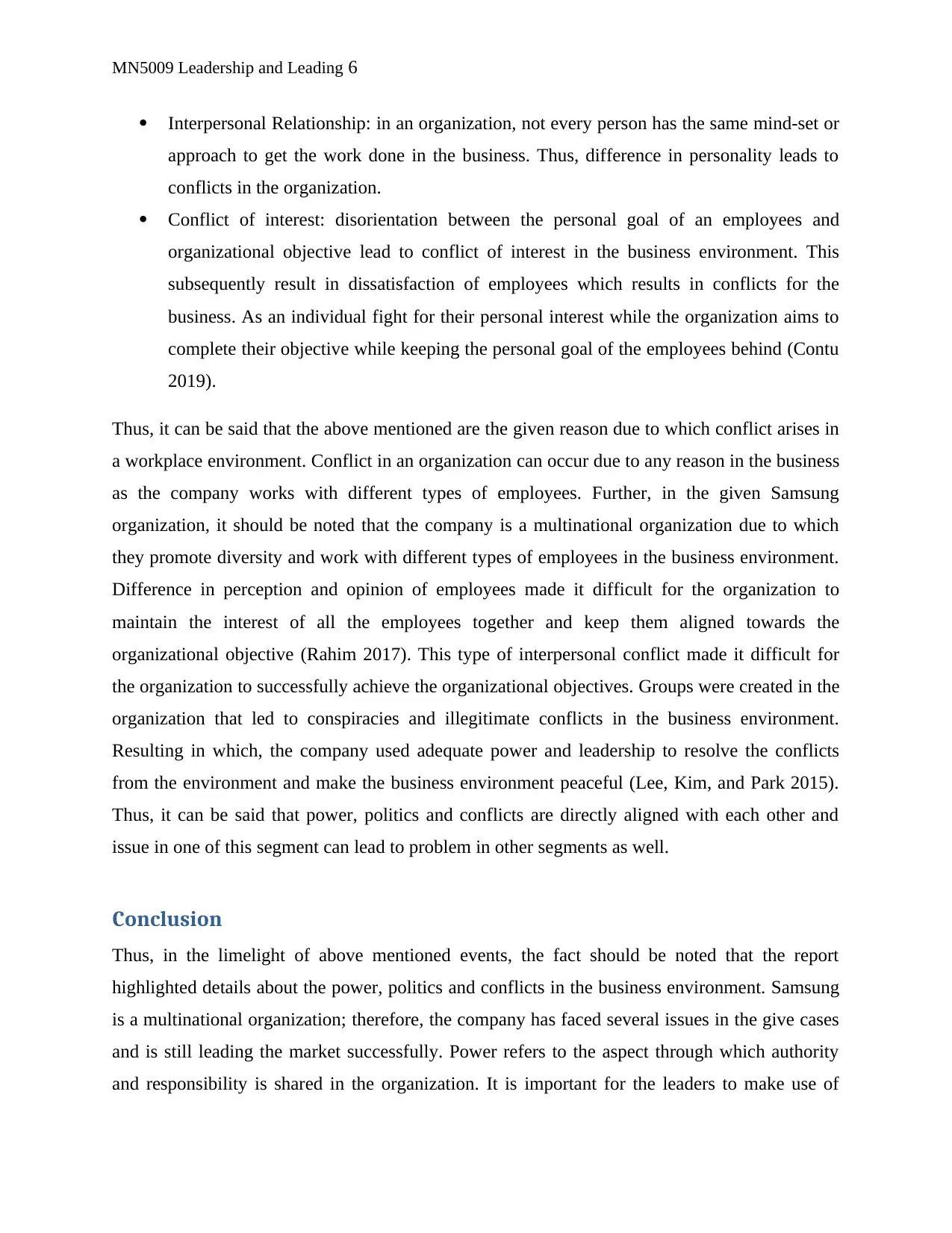
MN5009 Leadership and Leading 6
Interpersonal Relationship: in an organization, not every person has the same mind-set or
approach to get the work done in the business. Thus, difference in personality leads to
conflicts in the organization.
Conflict of interest: disorientation between the personal goal of an employees and
organizational objective lead to conflict of interest in the business environment. This
subsequently result in dissatisfaction of employees which results in conflicts for the
business. As an individual fight for their personal interest while the organization aims to
complete their objective while keeping the personal goal of the employees behind (Contu
2019).
Thus, it can be said that the above mentioned are the given reason due to which conflict arises in
a workplace environment. Conflict in an organization can occur due to any reason in the business
as the company works with different types of employees. Further, in the given Samsung
organization, it should be noted that the company is a multinational organization due to which
they promote diversity and work with different types of employees in the business environment.
Difference in perception and opinion of employees made it difficult for the organization to
maintain the interest of all the employees together and keep them aligned towards the
organizational objective (Rahim 2017). This type of interpersonal conflict made it difficult for
the organization to successfully achieve the organizational objectives. Groups were created in the
organization that led to conspiracies and illegitimate conflicts in the business environment.
Resulting in which, the company used adequate power and leadership to resolve the conflicts
from the environment and make the business environment peaceful (Lee, Kim, and Park 2015).
Thus, it can be said that power, politics and conflicts are directly aligned with each other and
issue in one of this segment can lead to problem in other segments as well.
Conclusion
Thus, in the limelight of above mentioned events, the fact should be noted that the report
highlighted details about the power, politics and conflicts in the business environment. Samsung
is a multinational organization; therefore, the company has faced several issues in the give cases
and is still leading the market successfully. Power refers to the aspect through which authority
and responsibility is shared in the organization. It is important for the leaders to make use of
Interpersonal Relationship: in an organization, not every person has the same mind-set or
approach to get the work done in the business. Thus, difference in personality leads to
conflicts in the organization.
Conflict of interest: disorientation between the personal goal of an employees and
organizational objective lead to conflict of interest in the business environment. This
subsequently result in dissatisfaction of employees which results in conflicts for the
business. As an individual fight for their personal interest while the organization aims to
complete their objective while keeping the personal goal of the employees behind (Contu
2019).
Thus, it can be said that the above mentioned are the given reason due to which conflict arises in
a workplace environment. Conflict in an organization can occur due to any reason in the business
as the company works with different types of employees. Further, in the given Samsung
organization, it should be noted that the company is a multinational organization due to which
they promote diversity and work with different types of employees in the business environment.
Difference in perception and opinion of employees made it difficult for the organization to
maintain the interest of all the employees together and keep them aligned towards the
organizational objective (Rahim 2017). This type of interpersonal conflict made it difficult for
the organization to successfully achieve the organizational objectives. Groups were created in the
organization that led to conspiracies and illegitimate conflicts in the business environment.
Resulting in which, the company used adequate power and leadership to resolve the conflicts
from the environment and make the business environment peaceful (Lee, Kim, and Park 2015).
Thus, it can be said that power, politics and conflicts are directly aligned with each other and
issue in one of this segment can lead to problem in other segments as well.
Conclusion
Thus, in the limelight of above mentioned events, the fact should be noted that the report
highlighted details about the power, politics and conflicts in the business environment. Samsung
is a multinational organization; therefore, the company has faced several issues in the give cases
and is still leading the market successfully. Power refers to the aspect through which authority
and responsibility is shared in the organization. It is important for the leaders to make use of
Paraphrase This Document
Need a fresh take? Get an instant paraphrase of this document with our AI Paraphraser
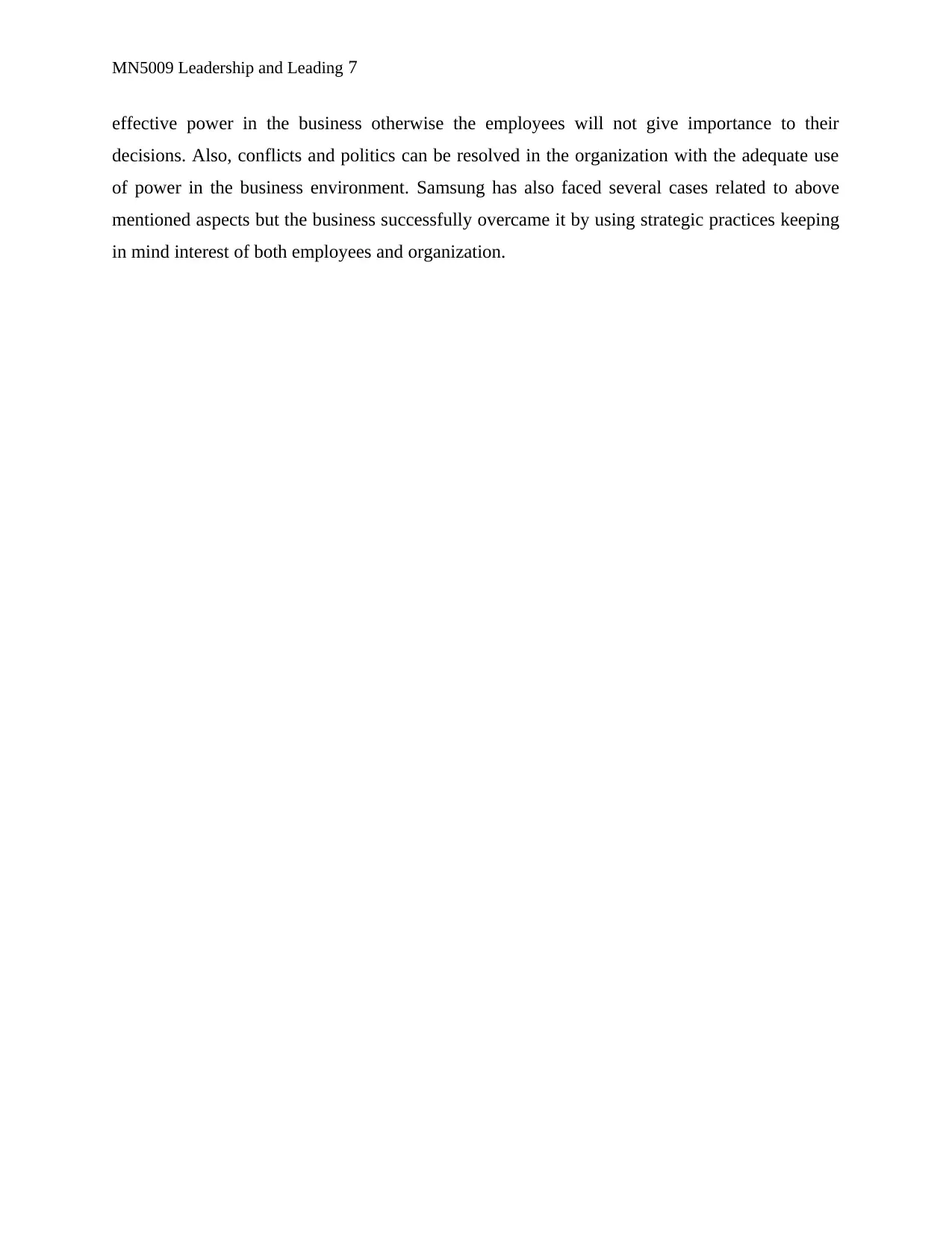
MN5009 Leadership and Leading 7
effective power in the business otherwise the employees will not give importance to their
decisions. Also, conflicts and politics can be resolved in the organization with the adequate use
of power in the business environment. Samsung has also faced several cases related to above
mentioned aspects but the business successfully overcame it by using strategic practices keeping
in mind interest of both employees and organization.
effective power in the business otherwise the employees will not give importance to their
decisions. Also, conflicts and politics can be resolved in the organization with the adequate use
of power in the business environment. Samsung has also faced several cases related to above
mentioned aspects but the business successfully overcame it by using strategic practices keeping
in mind interest of both employees and organization.
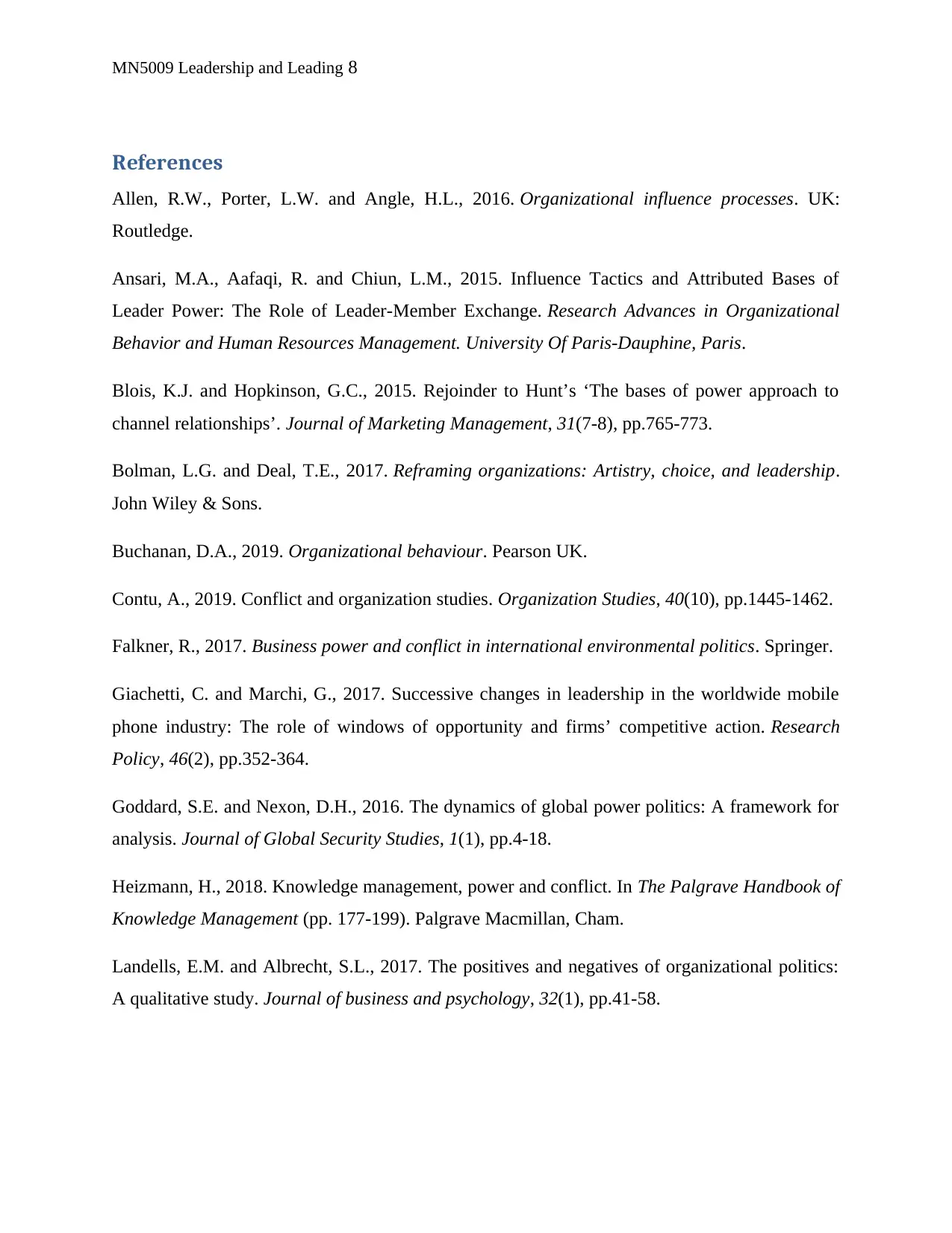
MN5009 Leadership and Leading 8
References
Allen, R.W., Porter, L.W. and Angle, H.L., 2016. Organizational influence processes. UK:
Routledge.
Ansari, M.A., Aafaqi, R. and Chiun, L.M., 2015. Influence Tactics and Attributed Bases of
Leader Power: The Role of Leader-Member Exchange. Research Advances in Organizational
Behavior and Human Resources Management. University Of Paris-Dauphine, Paris.
Blois, K.J. and Hopkinson, G.C., 2015. Rejoinder to Hunt’s ‘The bases of power approach to
channel relationships’. Journal of Marketing Management, 31(7-8), pp.765-773.
Bolman, L.G. and Deal, T.E., 2017. Reframing organizations: Artistry, choice, and leadership.
John Wiley & Sons.
Buchanan, D.A., 2019. Organizational behaviour. Pearson UK.
Contu, A., 2019. Conflict and organization studies. Organization Studies, 40(10), pp.1445-1462.
Falkner, R., 2017. Business power and conflict in international environmental politics. Springer.
Giachetti, C. and Marchi, G., 2017. Successive changes in leadership in the worldwide mobile
phone industry: The role of windows of opportunity and firms’ competitive action. Research
Policy, 46(2), pp.352-364.
Goddard, S.E. and Nexon, D.H., 2016. The dynamics of global power politics: A framework for
analysis. Journal of Global Security Studies, 1(1), pp.4-18.
Heizmann, H., 2018. Knowledge management, power and conflict. In The Palgrave Handbook of
Knowledge Management (pp. 177-199). Palgrave Macmillan, Cham.
Landells, E.M. and Albrecht, S.L., 2017. The positives and negatives of organizational politics:
A qualitative study. Journal of business and psychology, 32(1), pp.41-58.
References
Allen, R.W., Porter, L.W. and Angle, H.L., 2016. Organizational influence processes. UK:
Routledge.
Ansari, M.A., Aafaqi, R. and Chiun, L.M., 2015. Influence Tactics and Attributed Bases of
Leader Power: The Role of Leader-Member Exchange. Research Advances in Organizational
Behavior and Human Resources Management. University Of Paris-Dauphine, Paris.
Blois, K.J. and Hopkinson, G.C., 2015. Rejoinder to Hunt’s ‘The bases of power approach to
channel relationships’. Journal of Marketing Management, 31(7-8), pp.765-773.
Bolman, L.G. and Deal, T.E., 2017. Reframing organizations: Artistry, choice, and leadership.
John Wiley & Sons.
Buchanan, D.A., 2019. Organizational behaviour. Pearson UK.
Contu, A., 2019. Conflict and organization studies. Organization Studies, 40(10), pp.1445-1462.
Falkner, R., 2017. Business power and conflict in international environmental politics. Springer.
Giachetti, C. and Marchi, G., 2017. Successive changes in leadership in the worldwide mobile
phone industry: The role of windows of opportunity and firms’ competitive action. Research
Policy, 46(2), pp.352-364.
Goddard, S.E. and Nexon, D.H., 2016. The dynamics of global power politics: A framework for
analysis. Journal of Global Security Studies, 1(1), pp.4-18.
Heizmann, H., 2018. Knowledge management, power and conflict. In The Palgrave Handbook of
Knowledge Management (pp. 177-199). Palgrave Macmillan, Cham.
Landells, E.M. and Albrecht, S.L., 2017. The positives and negatives of organizational politics:
A qualitative study. Journal of business and psychology, 32(1), pp.41-58.
⊘ This is a preview!⊘
Do you want full access?
Subscribe today to unlock all pages.

Trusted by 1+ million students worldwide
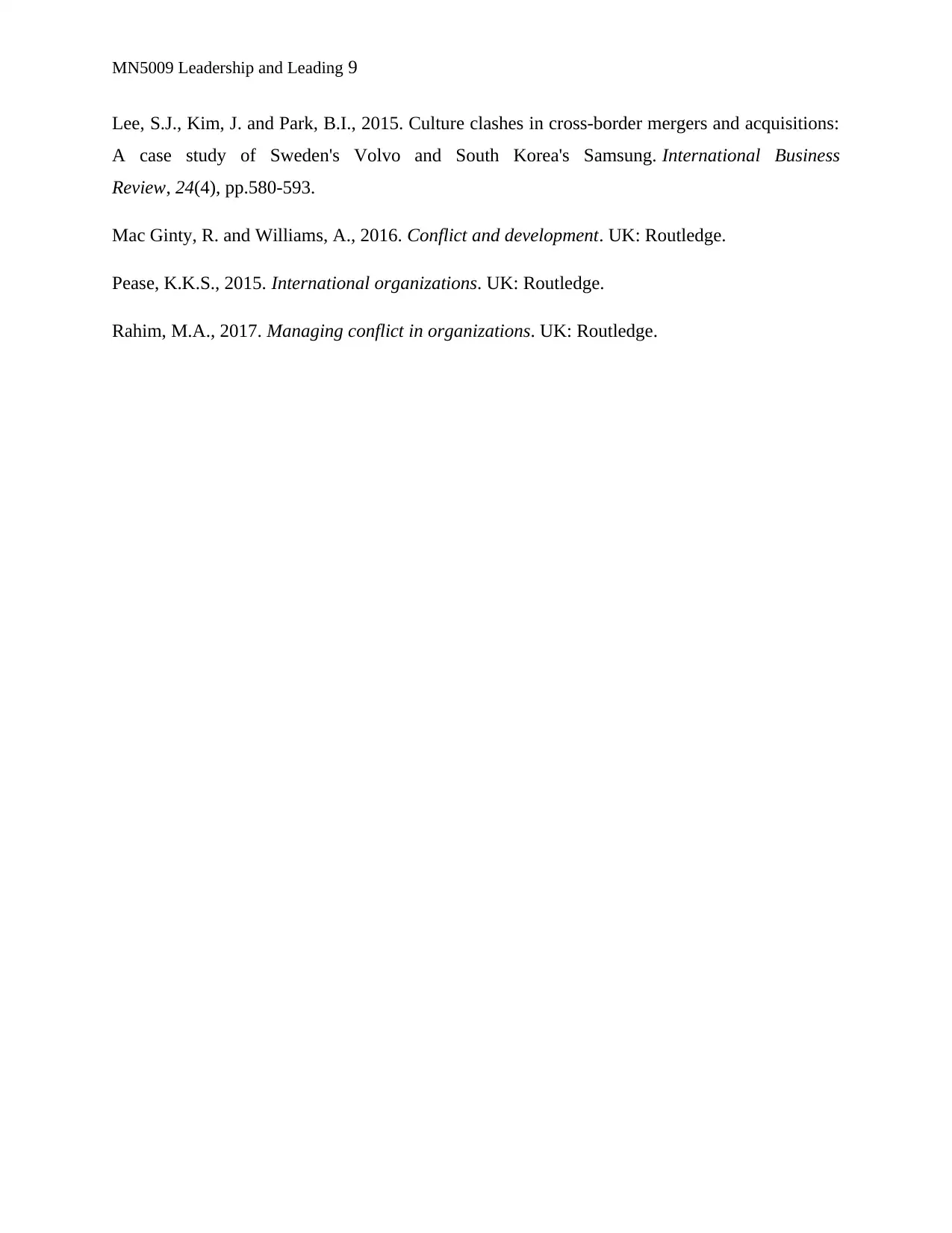
MN5009 Leadership and Leading 9
Lee, S.J., Kim, J. and Park, B.I., 2015. Culture clashes in cross-border mergers and acquisitions:
A case study of Sweden's Volvo and South Korea's Samsung. International Business
Review, 24(4), pp.580-593.
Mac Ginty, R. and Williams, A., 2016. Conflict and development. UK: Routledge.
Pease, K.K.S., 2015. International organizations. UK: Routledge.
Rahim, M.A., 2017. Managing conflict in organizations. UK: Routledge.
Lee, S.J., Kim, J. and Park, B.I., 2015. Culture clashes in cross-border mergers and acquisitions:
A case study of Sweden's Volvo and South Korea's Samsung. International Business
Review, 24(4), pp.580-593.
Mac Ginty, R. and Williams, A., 2016. Conflict and development. UK: Routledge.
Pease, K.K.S., 2015. International organizations. UK: Routledge.
Rahim, M.A., 2017. Managing conflict in organizations. UK: Routledge.
1 out of 10
Related Documents
Your All-in-One AI-Powered Toolkit for Academic Success.
+13062052269
info@desklib.com
Available 24*7 on WhatsApp / Email
![[object Object]](/_next/static/media/star-bottom.7253800d.svg)
Unlock your academic potential
Copyright © 2020–2025 A2Z Services. All Rights Reserved. Developed and managed by ZUCOL.





